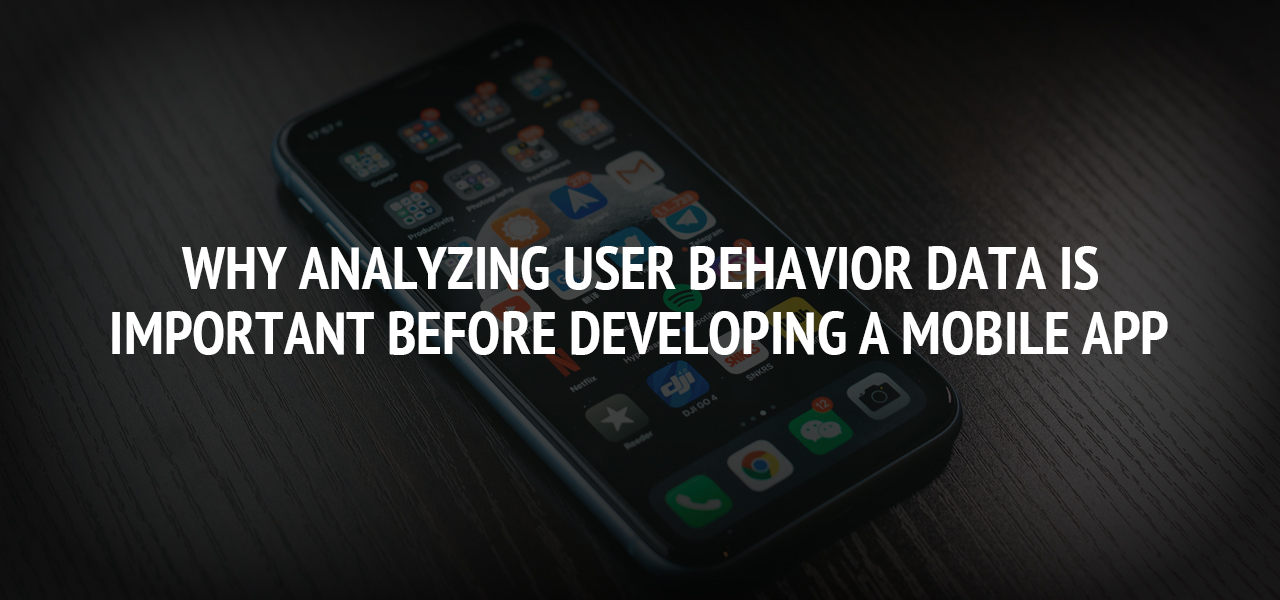Why Analyzing User Behavior Data is Important Before Developing a Mobile App

Introduction: Tell me one business that doesn’t aim to build a loyal customer base? You’re right, there isn’t! To get there, you require a precise combination of actionable strategies and well-structured plans. But there’s one more element that you cannot afford to miss and that is your mobile app. Why do I say that? Because of the simple formula - you need to be where your audience is. And in today’s day and age, your audience is on their smartphones - internet to be specific.
- 81% of smartphone users search for a product or service on the internet.
- 26% of these users search for applications related to the products/services they need.
Now you know why business must have an online presence through a dedicated website and mobile application. If you miss the chance to be there for your prospects, they’ll simply find an alternative that is available for them.
Now that we truly understand that mobile apps are a necessity for businesses - we can begin to discuss what you need to consider to build an effective one.
Importance of Analyzing User Behavior Before Developing the App
Before developing a mobile app - you need to understand the needs and requirements of your customers. A thorough analysis is necessary to figure out the factors that will contribute to customer retention, user engagement, and conversion. User behavior data is majorly important for the conversion of ad budgets to installs, repeated app usage, and in-app purchases.
Analyzing user behavior will also help you decide the ideal layout and design of the app in a way that is most convenient to your users. Only when you know how the users will use the app and what will engage them the most, you’ll be able to design an effective UX.
Also, ask questions like:
- What kind of applications do your customers prefer to download?
- Will your customers be interested in making an in-app purchase?
Now, the answers to these questions are going to vary depending upon the OS your customers use. You, therefore, must know the difference in the behaviors of Android and iOS users. That will help you determine which group is suitable for your business so that you can select the right platform to develop the app.
Here’s what you need to consider while Analyzing User Behaviour Data
-
The User’s Goal: The foremost factor you need to consider before developing an app is the end goal of your user. You need to understand why the user will want to use your app. What goal do they have in mind while using the app? You need to understand this goal and help your users achieve it effectively.
Take Uber, for instance. We use Uber because of the experience it serves us with. The Uber app allows us to book our rides from the convenience of our homes, the ride arrives at our doorsteps, and we know the fare beforehand so there’s no confusion or haggling. The entire experience is filled with comfort and convenience and that’s exactly what users have in mind when they are using the app.
-
Mobile usage: At the designing stage of the app, pay special attention to - how your users use their smartphones. There’s no rocket science here - your users are going to use the app on their smartphone, so you need to design it in a way that is most convenient to them.
If you fail to align the app’s design with how the majority of users use the smartphone/app, you’re going to lose out on a lot of customers.
Here’s what matters:
- 79% of people use their left hand instead of the right hand to hold their smartphones or use the apps. You need to consider that while designing the app.
- Most individuals use the applications in the portrait mode. However, when they are viewing videos, they prefer to keep their smartphones in the landscape mode. This preference needs to be given importance while designing the app.
- Explore whether users use their thumb to access the options on the screen or their finger. Do they prefer to hold their phone in one hand or use both hands? How do they navigate through the screens?
- What is the best position to place the clickable elements of your app so that they aren’t on the inaccessible part of the mobile screen?
You need to know the answers to these questions before finalizing the design strategy. Remember, the best design is the one that your users prefer.
-
Feedbacks are imperative: The fool-proof method to understand your users - correctly and thoroughly - is to ask them. What are the elements of the app that your users prefer? What interests them the most, what do they dislike, what frustrates them, what would they like to change? The flow of communication between you and your users must be such that you receive the answers (feedback) to the mentioned questions.
The general understanding is that users do not like the apps that aren’t designed well. Or the ones that take more than 3 seconds to load. Suppose you build an app that fulfills all the needs but its images take a lot of time to load, which is quite often the case with e-commerce apps, do you think your users will prefer this app?
The apps need to be quick to address the concerns of its users. Only then they’ll be able to sustain and stand ahead of the market competition.
-
Motivations matter: After doing all of the above, you finally need to understand the motivations of the individuals using your app. What drives them to use your app? Why will they want to prefer your app to other similar apps?
What encourages them to complete an action in the app? What makes them take action - click on the buy now tab - in your app? To get answers to these questions, you need to study your users. Generally, safety and value for money are some of the major motivators for users.
Conclusion: Now that you the importance of analyzing the user behavior data before developing an app for your business and the factors you need to consider during the process, I’ll leave you with two simple methods of doing it.
First in the list is an obvious one - a questionnaire - with all the relevant questions that give you an insight into the user’s behavior. The second one is Mobile App Analytics Platforms - to help you identify how users are interacting with screens and how they move through your app.
About The Author
Related Blog
View All-
How Mobile Apps Can Promote Your Business and Brand
With high speed internet becoming more readily available than ever before and tech giants like Facebook and Google using their billions to provide free internet access all around the world, nearly half the world's population is regularly using the internet. King ...
-
Best Apps that Help Stream HD Quality Videos Online
When you are tired of waiting, one of the most exciting activities is streaming movies or tv series on streaming applications. Along with the times, watching movies does not only have to go to the cinema. Only by streaming can you enjoy your favorite series and ...







